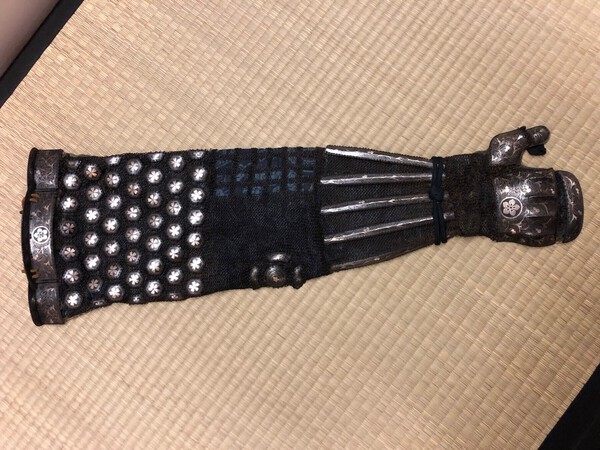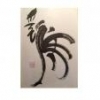Leaderboard
Popular Content
Showing content with the highest reputation on 12/17/2021 in all areas
-
some small additions: Regarding jidai: 初期 - shoki - early 中期 - chuki - mid 末期 - makki - late Regarding inlay: 銀象嵌 - gin-zōgan - silver inlay 平象嵌 - hira-zōgan - flat inlay (flush) 据文象嵌 - suemon-zogan (to inlay a separately made design or motif) Regarding openwork: 糸透 - ito-sukashi (line/thread openwork) 小透 - ko-sukashi (small sukashi) Regarding surface: 阿弥陀鑢目 - amida-yasurime - radiating lines starting from the center 時雨鑢目 - shigure-yasurime - slanting lines that resemble rain4 points
-
I have taken the time to complie a list of commonly encountered terms on NBTHK tōsōgu kanteisho. More specifically, the physical attributes which are listed after the description/ theme and attribution. My reason for putting these terms together is twofold: Firstly, a lot of diligent members put in the effort to try and figure out what is written on kanteisho before asking members for clarification. For such people, this will provide a quick reference to check common terms in the description to aid their own progress. Secondly, when members ask for a translation their reason is usually to obtain further information about the item which has been appraised. In such a case, translators (including myself) often only provide the description/ theme and attribution, since there isn’t much need to describe what can be seen. Should such members become curious about the other characters on a kanteisho they will be able to find them here. I would like to note that this is by no means an exhaustive list, but common terms which I found on kanteisho of tōsōgu in my own collection [I realise there are dozens of other tsuba shapes which I have not included]. And as such, I encourage members to add any further terms which they may encounter. Also, the English translations in brackets are mostly direct translations to explain the work/technique, rather than a definitive account. For convenience, I have listed the terms in order of appearance on the kanteisho. That is, after the description/ theme of the tsuba, is the mei or attribution [on some menuki the way the signature is applied is given], this is followed by the shape [for tsuba], the material the item is made from, the style of carving, the method of inlay, and the style of the rim [on tsuba]. Way of signing [on menuki] 短冊銘 - tanzaku-mei (signed on an inserted plaque) 割根先銘 - warinesaki-mei (signed on the support post) Shape [of tsuba] 丸形 - maru-gata (round) 竪丸形 - tate maru-gata (oblong round) 撫丸形 - nade maru-gata (smooth round) 木瓜形 - mokko-gata (four lobes) 角形 - kaku-gata (square) 撫角形 - nade kaku-gata (smooth square) 菊花形 - kikka-gata (chrysanthemum) 車形 - kuruma-gata (wheel) 葵形 - aoi-gata (hollyhock) 泥障形 - aori-gata (saddle) 変り形 - kawari-gata (unusual) 椀形 - wan-gata (domed/bowl) Material 鉄地 - tetsu-ji (iron) 赤銅地 - shakudō-ji (copper mixed with gold) 素銅地 - suaka-ji (copper) 四分一地 - shibuichi-ji (copper mixed with silver) 山銅地 - yamagane-ji (unrefined copper) 真鍮地 - shinchu-ji (brass) 金無垢地 - kinmuku-ji (solid gold) Surface 磨地 - migaki-ji (polished) 魚子地 - nanako-ji (fish eggs) 石目地 - ishime-ji (stone) 槌目地 - tsuchime-ji (hammered) 斜鑢地 - shayasuri-ji (diagonal filing) Openwork 地透 - ji-sukashi (openwork) 影透 - kage-sukashi (silhouette openwork) Carving 肉彫 - niku-bori (dimensional carving) 高彫 - taka-bori (high relief carving) 容彫 - katachi-bori (shaped) [common for menuki] 片切り彫 - katakiri-bori (half-cut carving) 毛彫 - ke-bori (hair line carving) 鋤出彫 - sukidashi-bori (dug away carving) 深彫 - fuka-bori (deep carving) 甲鋤彫り - kōsuki-bori (shell-shaped carving) 倶利彫 - guru-bori (level carving) Decoration 象嵌 - zōgan (inlay) 金象嵌 - kin-zōgan (gold inlay) 平安城象嵌 - Heianjō-zōgan (brass inlay) 素銅象嵌 - suaka-zōgan (copper inlay) 布目象嵌 - nunome-zōgan (crosshatch overlay) 色絵 - iro-e (colour overlay) 金銀色絵 - kingin iro-e (gold and silver colour overlay) Rim [on tsuba] 丸耳 - maru-mimi (round) 角耳 - kaku-mimi (square) 土手耳 - dote-mimi (piped) 打返耳 - uchigaeshi-mimi (bevelled) 鋤残耳 - sukinokoshi-mimi (carved down) 覆輪耳 - fukurin-mimi (metal band) 鋤出耳 - sukidashi-mimi (dug away)3 points
-
2 points
-
1 point
-
https://artsandculture.google.com/asset/akaito-odoshi-yoroi-armour-laced-with-red-thread-nishioka-fumio/XgHdL1KHu7fPeQ What would we guess the cost of a commission such as this? Are there any pricing details for Nishioka Fumio San's work? I'm assuming it compares reasonably favourably to the original on which its based, and given the stated time taken to craft it, I'm assuming the cost would be somewhere in the region of ¥50,000,000.1 point
-
Item No. 174 Iron Tsubas 7.63 cm x 7.32 cm x 0.50 cm and 7.20 cm x 6.93 cm x 0.50 cm Subject of dragons in clouds - Choshu school signed as Tomokiyo & Nobuhisa An associated ' daisho ' pair . Is it possible to check these signatures / attributions against Wakayama or Haynes ? The only reference I can find in geneologies places the artist at the turn of the 17th/18th centuries. In very good condition for their apparent age. Item No. 175 Iron Tsubas 8.09 cm x 8.04 cm x 0.30 cm and 7.74 cm x 7.64 cm x 0.34 cm Another associated pair described as ' Ko Tosho cherry blossom & mon '. Received opinion is that the blossom is in fact a Katabami flower , a mon of the Chosokabe clan . The angular cut out is Genji Monogatari , an Incense Game symbol. Any ideas about the mon or perhaps stylised flower on the right ? Deep lustrous patinas on both these pieces.1 point
-
1 point
-
“Ship of Theseus”, it couldn’t be better described Mark! There are different approaches when it comes to restoration/preservation…..already (and repeatedly) discussed until exhaustion…. The display case variant is a good idea. It allows you to control humidity and temperature more properly and it will protect your wife from the smell Yes, there are some newly made “replacement armors” (copies of important pieces) in shrines and museums. But that is another story… Maybe one example. Nishioka Fumio (and his workshop) once produced a reproduction of the “Akaito Odoshi Yoroi” (National treasure of Musashi Mitake Shrine) for the Ōme City Folk Museum. It took him 3 and a half years and he didn’t work on it alone!1 point
-
Hi Mark, If you want a quality restoration performed on antique Japanese armour , please contact David Thatcher at his UK based Koubou. https://yoroi.uk/ Dave works only with traditional materials. Jon.1 point
-
I was following this tsuba as well, seeing you don't see good Sendai that often, well done Luca!1 point
-
Hello Marcus, I'm a bit of a history buff, so a little more details for you. The only Head Hunters of any marked claim were located on the island of Borneo, no where near Burma/Thailand/Laos/Cambodia/Vietnam. If I recall correctly, the last claimed occurrence of any headhunter falderal was in the late 1800's-early 1900's, but I have not delved into that to any extent. Borneo swords and knifes are dramatically different in shape/style/form. As far as The US being on the ground in South East Asia during WWII, that was extremely limited, a few combined tiny efforts with the British in Burma, and an air war campaign out of china called the "Flying Tigers", but that was air warfare only, no boots on the ground. There was no "tours of duty" on the South East Asia mainland during WWII for the US. There were no US bases/outposts anywhere on the mainland. The US military action was island hoping warfare only. With that being said, once the war ended, there was a fair amount of allied visiting of many South East Asian countries, helping with rebuilding and such, so......maybe then??? Mark1 point
-
Luca, as the ‘Mon’ is on one side only, I think ‘lucky pattern’ is probably right.1 point
-
This is not a stamp but I am sure it will interest some members. A five dollar silver coin from Samoa. https://www.govmint.com/2021-samoa-2oz-silver-samurai-war-mask-bu-coin-w-packaging - https://www.moderncoinmart.com/2021-samoa-samurai-war-mask-2-oz-silver-5-coin-gem-bu-ogp-sku64123.html Also in California - https://thecoinshoppe.ca/product/samurai-mask-ancient-warriors-2021-2-oz-pure-silver-coin-samoa/ or you can buy one from ebay for only twice as much! https://www.ebay.com.au/itm/185150235224 https://agaunews.com/a-samurai-mask-of-the-Japanese-feudal-period-launches-lpms-ancient-warriors-series-of-dimensional-silver-coins/1 point
-
1 point
-
Have a look at "Begin Japanpology -Armour" on Youtube. I saw a modern O Yoroi in the Tokyo National Museum in Ueno Park a few years ago, if it was good enough to display there i imagine it was of suitable quality. i dont remember who made it, there are a few people specialising in traditionally made armour. regards chris colman1 point
-
1 point
-
Folks...stop it. His name is in his signature. That is ALL that is required. If people in Germany or elsewhere want more details...ask him. There is no need for anyone to cross question someone who has been here for 9 years. I can't vouch for the service, but if you want to know more...ask him via pm as requested. And those on cell who can't see signatures, that is due to space constraints on the tiny screens. I can open it, but then ppl will cry about cluttered screens. Chill. It's the end of the year. Relax.1 point
-
Hi Mark, I hesitated to give an opinion cos when it comes to contemporary (modern made) Japanese armor there is a remarkable gap of knowledge with me. Who comes in mind is Michael Asterita from “Iron Mountain”, for example. One of a few people who may could help you with this task?! Anyway, if you like it traditionally made with the same standards and quality as in Edo times, you probably won’t find somebody…..at least not for affordable costs, I guess. As a side note, at the price of the armor you posted above, you can fairly get an historical set!1 point
-
yes, why would anyone trust you with their items if you refuse to even provide name / fees/ information?1 point
-
I don't know if I'm interested without some more information. Why do you want to keep everything obscured and waste time covering these things privately in PM?1 point
-
AT the risk of boring readers (I have posted these images before) attached 2 pictures of Nashiji hada which I hope might help you to identify what you are looking at. Basically nashi hada is extremely fine ko-itame hada covered with a profuse amount of ji-nie. If this a Yamashiro work you should also look for the hamon being predominantly ko-nie on an bright nioiguchi. There should be a lot of very bright activity such as inazuma and kinsuji running through the hamon.1 point
-
Here's something to get you going, this is a glossary I compiled for myself - apologies for the formatting and the way it is copied across: Types of sword 太刀 – Tachi 刀 – Katana 脇差 – Wakizashi (alternative 脇指) 短刀 – Tanto 槍 – Yari (alternative 鑓) 薙刀 – Naginata 長巻 – Nagamaki Sword shapes 造込み – Tsukurikomi – The shape of the sword as a whole 姿 – Sugata – figure, form, shape 鎬造 – Shinogi zukuri 平造 – Hira zukuri 菖蒲造 – Shobu zukuri 鵜 の 首 造 – Unokubi zukuri 冠落とし 造 – Kanmuri otoshi zukuri 両刃造 – Ryoba zukuri 片切刃造 – Katakiri zukuri Dimensions 刃長 or 長さ– Hachō or nagasa – length of cutting edge 幅 – Haba – width 身幅 – Mihaba - width (alternatively 身巾) 元幅 – Motohaba – width at the part nearest the tang 先幅 – Sakihaba – width at the yokote 元重 ね– Motokasane – breadth at the machi 先重ね – Sakikasane – breadth at the yokote 反り – Sori - depth of curvature (腰 – koshi – deepest nearest the tang, 鳥居 – torii – deepest in the middle or 先 – saki – deepest nearest the tip) 厚 (ku) – Atsu(ku) – thick/ thickness 差 – Sa – difference 深 – fuke – deep (re sori) 踏張り – Funbari – noticeable widening of the blade at the machi 部分 – Bubun – section or part Units of measurement 尺 – Shaku (30.3cm) 寸 – Sun (3.03cm) 分 – Bu – (3.03mm) 厘 – Rin (0.3mm) Parts of the sword 鋒 – kissaki – point 帽子 – Bōshi – shape of hamon within the kissaki 中子 or 茎 – Nakago – tang (alternative means “stem”) 尻 – Jiri – butt (of tang nakago jiri) 棟 – mune 横手 – Yokote 三つ角 – mitsukado 区 – machi – notches just before tang 刃文/刃紋 – hamon – hardened edge of sword 焼(き)刃 – Yakiba – hardened edge of sword 焼頭 – yakigashira – start of the hardened edge of the sword 地肌 – Jihada – texture of folded metal above the hamon; also 鍛え – Kitae – forging 佩表 – Haki omote – side of sword facing outwards when worn 佩裏 – Haki ura – side of sword facing the body when worn 鑢目 – Yasurime – file marks on tang 目釘穴 – Mekugi ana (sometimes “ana” = 孔) – hole in tang for retaining peg 個 – Ko – Counter for mekugi ana Types of forging pattern 板目肌 – Itame hada – wood grain 杢目肌 – Mokume – wood burl grain 綾杉肌– Ayasugi hada – wavy pattern 柾目肌– Masame hada – straight grain 梨子地肌 – Nashiji hada – pear skin pattern 小糠肌 – Konuka hada – rice bran pattern 松皮肌 – Matsukawa hada – pine bark pattern 肌立 – Hada tachi – hada that stands out 流れ – nagare - flowing Types of hamon 乱れ – Midare – irregular pattern 直刃 – Suguba – straight hamon 互の目 – Gunome – half-circle pattern 尖刃 – Togariba – pointed pattern 濤瀾乱刃 – Toranba – irregular rolling wave pattern 飛焼 – tobiyaki – hardened areas above the hamon 皆焼 – hitatsura – “everything hardened” Effects within the ji and hamon 暗帯 – antai - the dark areas between nioiguchi and border of the utsuri 段映り – Dan utsuri – utsuri comprised of various layers 地斑映り- jifu utsuri – if jifu spots appear all over the blade and form a pattern this term is used. It is rare and hardly appears after the nambokucho period but is typical for Ko-Bizen, Un group and Aoe swords. 景刃文 – kage hamon – shadow hamon: another name for utsuri 匂 – Nioi – small, indistinct martensite crystals (think of the milky way) 沸 or 錵 – Nie – martensite crystals that can be seen individually (think of individual stars within the milky way) 出来 – Deki – manufacture, style (used in combination with nie or nioi indicating predominantly one or the other. 足 – Ashi – Feet 金筋 – Kinsuji – black line of nie in the hamon (if straight) 稲妻 – Inazuma – literally lightning bolt – kinsuji that are zigzag shaped 砂流し – Sunagashi – brushed sand effect 湯走り – Yubashiri – “hot running water” – formations of ji nie 地景 – Chikei – “Shadows in the steel”- black lines of nie in the Ji – the same substance as kinsuji 縮緬 – chirimen – crepe paper (chirimen hada refers to a style of forging pattern in the Aoe school) Carvings 棒樋 – Bo hi – a single straight groove 添樋 – Soe bi – “accompanying groove”- single narrow groove below a bo hi 止め – Dome – the end of a groove 丸止め – Maru dome – round end of a groove ending before the habaki 掻く – Kaku – to scratch (re making of groove) 梵字 – bonji – Sanskrit symbol 素剣 – suken – carving unadorned sword Nakago 磨上 – Suriage - shortened Styles of yasurimei 鑢目 – Yasurime – file marks 大筋違 – Osujikai – greatly slanting file marks 化粧 – Keshō – “Make up”- style of yasurimei occurring in the Shinto period and later 刻む – Kizamu – To engrave Time 年紀 – Nenki – date/ period 年号 – Nengo – Generic name for the Japanese eras corresponding to the reign of an emporer 時代 – Jidai – era or age – can refer to a nengo era. 鎌倉– Kamakura [jidai] 南北朝 – Nambokucho – Northern and southern courts period 室町 – Muromachi 安土桃山 – Azuchi-Momoyama 江戸 – Edō 幕末 – Bakumatsu – end of Edo period “end of Bakufu” 現代 – Gendai - modern 前期 – Zen Ki – Early period 後期 – Kō ki – late period 歳 – Sai – Years of age (suffix)1 point
-
I have been to Numa Numa. It is a coconut plantation on the coast of Bougainville Island in the Solomons just outside the town/harbour of Wakunai. It was back in 1975...I rode a motorbike up the coast from Arawa. There was some hard fighting there in 1944/45. I remember some bomb craters between the rows of trees and and a wrecked Australian tank on the side of the road....but I don't remember seeing those guys, or those swords...sorry. Those were the days,1 point
-
1 point
-
1 point
-
gets very close but as it is so old it can be forgiven, sure it has seen so many battles through the ages,I did find a surrendering officer from the area were it was supposably captured with the same name as the family mon on it, who was for a japapanese person quite tall ,the sword must have belonged to someone of large stature so I assume that it must have belonged to Lieutenant General Hidemitsu Nakano who's father had been a samurai retainer1 point
-
The writing in the bit that seems a bit recessed inside the tang is an invocation of a buddhist god (well, buddhist by way of hinduism). 大聖観喜天 - Daishōkangiten https://en.wikipedia.org/wiki/Kangiten1 point
-
1 point
-
0 points
-
0 points
-
0 points


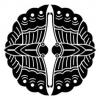



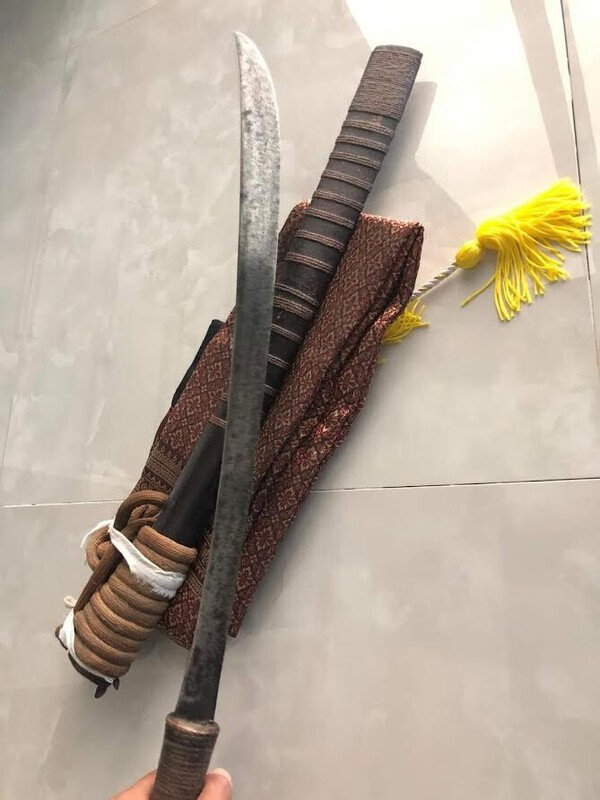

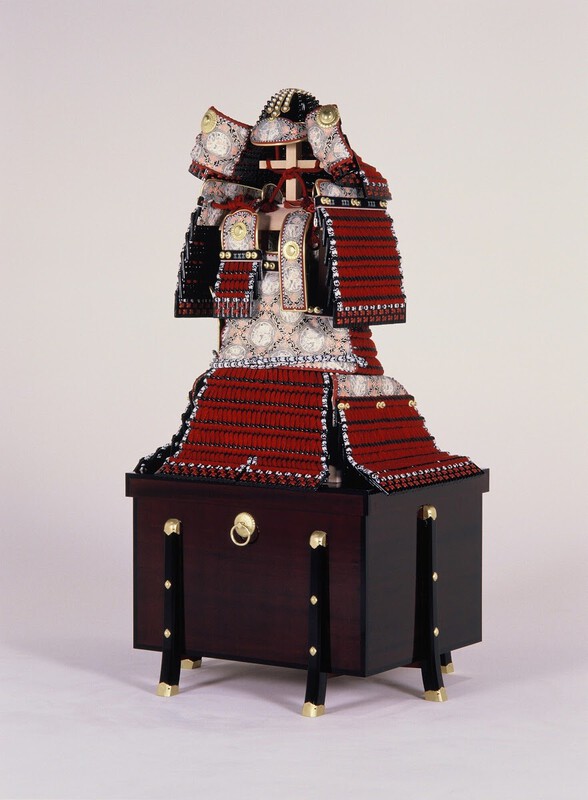




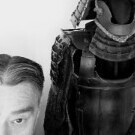

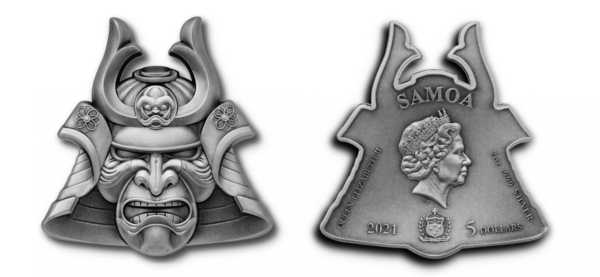

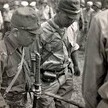



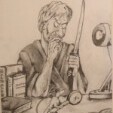




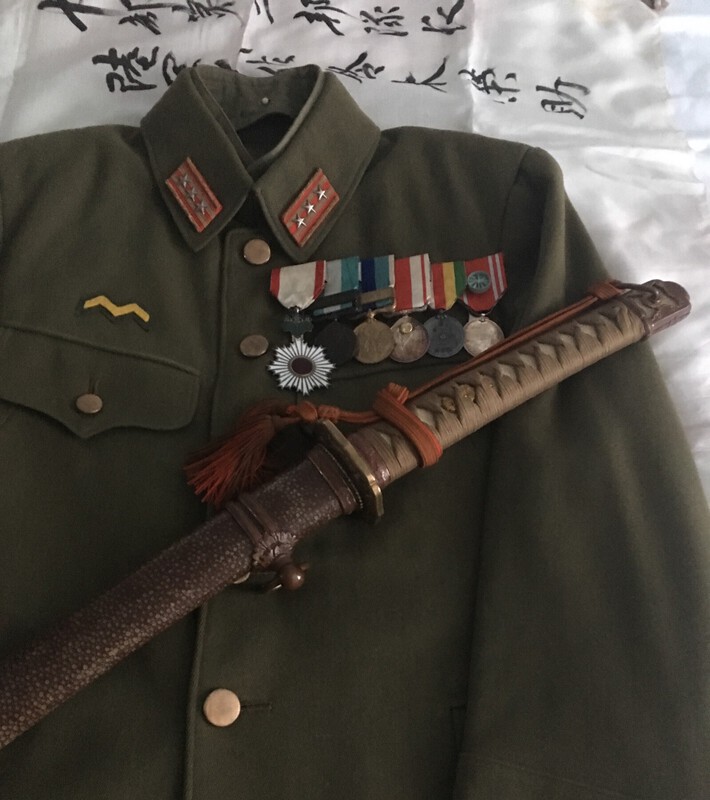





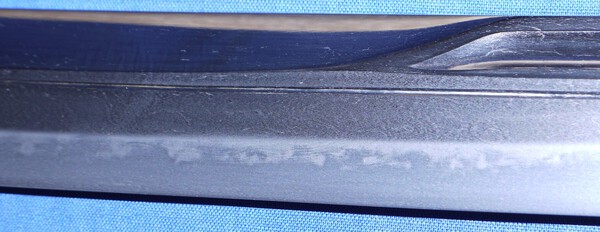


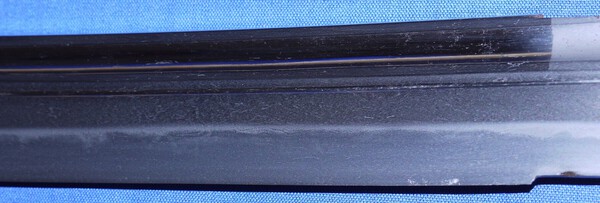


.thumb.jpg.741ed7ea21e8240f70ff93c4e50b8bf2.jpg)
